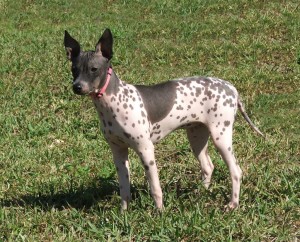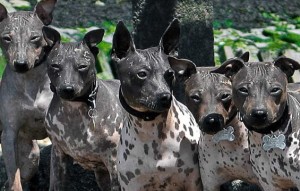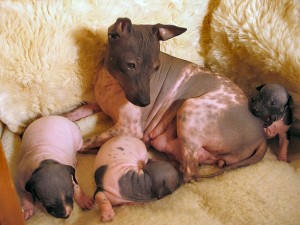History
The American Hairless Terrier's American ancestry begins with the mixed breed terriers called Feists brought from Europe to North America as early as the 18th century. In the late 1800s the Rat Terrier breed was developed from the Feist by the addition of Beagle, Italian Greyhound and Miniature Pinscher bloodlines.
The distinct American Hairless Terrier breed began in 1972 when one hairless puppy named Josephine appeared in a Rat Terrier litter in the state of Louisiana, United States. Owners Edwin and Willie Scott liked the dog's look and temperament, and upon maturity bred her hoping to reproduce the hairless quality. They were eventually successful; a litter produced in 1981 provided the foundation stock of the breed.
Breed recognition
In 1998, the breed gained recognition as the American Hairless Terrier (AHT) by the American Rare Breeds Association and the National Rat Terrier Club. Canada was the first country outside the US to gain recognition, by Canadian Rarities in 1999. In 1999, the breed was recognized as Rat Terrier, Hairless Variety by the United Kennel Club.
In the US, the American Hairless Terrier Association is the provisional breed club. Other national breed clubs around the world include the Canadian American Hairless Terrier Association and the Japanese Hairless American Terrier Club.
On January 1, 2004, the United Kennel Club (UKC) recognized the AHT as a distinct breed.
The American Kennel Club (AKC) also includes the AHT within its Foundation Stock Series and allows them to participate in AKC Performance events and in Open shows.
Despite its smaller size, the AHT is not a toy breed. Rather, like its Rat Terrier cousin, the AHT is a working breed.
In January 2016 the American Hairless Terrier will be recognized fully by the AKC in the terrier group.
Description
The American Hairless Terrier is a smoothly muscled, active, small-to-medium terrier.
Height: 7-18 inches (18–45.7 cm.)
Life Span: 14–16 years.
Weight: 7-25 pounds (2.5–12 kg.)
Skin Color: White (to varying degrees) with a variety of colors including black, blue, pink, brown, tan, and sable. Skin color darkens with sun
Eye Color: Brown, blue, grey, amber and turquoise
Pattern: near-solid (with some white), brindled, spotted (piebald) and saddled
Tail/Ears: Tails must be left long on the hairless variety, coated may be docked or left undocked
Type: Working Breed
American Hairless Terrier and Rat Terrier distinctions
The American Hairless Terrier's origins are unique in that the entire breed originated from a single hairless Rat Terrier female born in 1972. The AHT is therefore very similar to the Rat Terrier and the coated AHT is almost indistinguishable from its Rat Terrier cousin.
However, since the first litter born in 1982 from the originating hairless female, the AHT has continued to be developed as a distinct breed (see "Breed Recognition") with several characteristics that distinguish the AHT from its Rat Terrier origins. These differences include smaller sizes, more refined features, new eye colors, new patterns, new (skin) colors and, of course, a complete lack of fur on the hairless variety.
Other breeder choices have further differentiated the AHT. AHT breeders and clubs promote the undocked tail appearance on hairless, unlike the more traditionally docked appearance of the Rat Terrier. To date, the hairless trait has not been bred over to the other types of Rat Terrier such as the Giant Decker Rat Terrier or the Type B Rat Terrier (also known as the Teddy Roosevelt Terrier).
Hairless breeds and genetics
While there are unproven theories that other hairless dog breeds have common ancestry, the recent evolution of the American Hairless Terrier demonstrates an independent evolution from other hairless breeds.
A key difference found between the American Hairless Terrier and other Hairless Dog breeds is that the AHT's hairless gene is recessive, while the gene for hairlessness found in the ancient breeds is a lethal dominant.
The American Hairless Terrier does not have dental issues (absent premolars) or other characteristics associated with the dominant hairless gene.
For dogs where hairlessness is a dominant gene, hairless to hairless mating will on average produce 66.6% hairless and 33.3% coated puppies. For hairless to coated mating, there will be an average one to one ratio between coated and hairless offspring. In coated to coated mating, all puppies will be coated.
Mating between hairless AHTs will produce completely hairless litters. Between hairless AHT to coated AHT or Rat Terrier, results are more variable and will produce mixed hairless litters to all coated litters.
Hypoallergenic dog breed
There is no scientific evidence supporting the existence of a completely hypoallergenic dog breed and hairlessness is not the sole characteristic that will determine allergic reactions or its degree.
The American Hairless Terrier Association recommends individual allergy tests prior to adopting an AHT.
Temperament
The American Hairless Terrier (AHT) is an intelligent, curious, and energetic breed.
Graceful and elegant, the American Hairless Terrier is also strong and athletic. The AHT enjoys participating in agility games like its other terrier cousins. The AHT typically likes to dig, chase small game and will bark when alarmed and will act as a good watch dog. The AHT is not a strong swimmer and should be monitored around water.
Its ancestry gives the AHT a strong hunting instinct, but its lack of coat makes it a less likely candidate for a hunting dog as rough underbrush may hurt the AHT's unprotected skin. As a breed founded by working dogs, the prey drive is strong in many AHTs. This has led to debate among owners as to whether or not AHTs are appropriate for families with young children. Anecdotal evidence suggests that AHT's can be trained to be less aggressive to children, especially if the dog is shown that it may not dominate a child. Due to the small size of many AHTs, they can be hurt if roughly handled. Positive reward is the most effective form of training, however, some AHT require a more care-giver dominant approach to correction in giving the AHT direction.
Health
The American Hairless Terrier continues to be a rare breed with a limited breeding stock. The UKC recognizes the need to continue to breed in Rat Terrier blood lines.
Although often stated otherwise, AHTs do not have sweat glands. However, after physical exertion or in warm temperatures, the breed exhibits dermal evidence of moisture along the spine, typically lower spine. There is no scientific evidence to suggest an independent evolution of sweat glands unique to this breed. The mis-perception has likely arisen from the presence of sebaceous glands associated with hair follicles. These are the same glands that are present in all canines. The hairless variety of this breed has the same follicles, however the "hair" is lost early on as the dog matures.
Rashes due to grass allergies are not entirely uncommon. Other allergies may occur as well, but this is no different from most other breeds of dogs. Due to their lack of hair, they may need protection from the sun (based on the season, their geographic location and the individual dog's degree of pigmentation or lack thereof). If needed, sunscreen can be applied or a light shirt may be worn. Clothing is oftentimes used, not only for the protection from the sun but from the cold as well (where the climate warrants). It is, however, important to keep the skin clean with regular, possibly daily depending on application of sunscreen or moisturizers, bathing with gentle soap to prevent infections in the skin pores (acne).

An American Hairless Terrier
|
|||||||||||||||||||||
| Common nicknames | AHT | ||||||||||||||||||||
|---|---|---|---|---|---|---|---|---|---|---|---|---|---|---|---|---|---|---|---|---|---|
| Origin | United States | ||||||||||||||||||||
|
|||||||||||||||||||||
|
|||||||||||||||||||||



